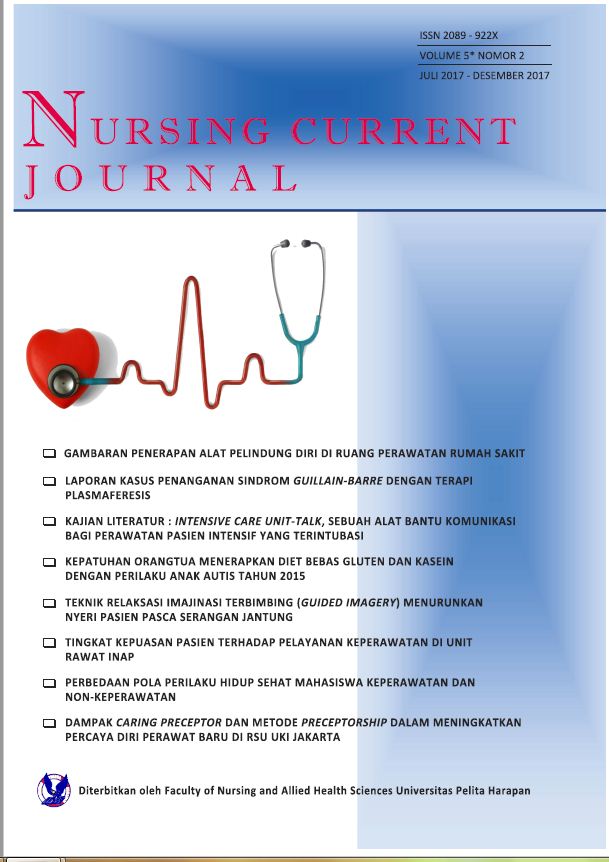GUILLAIN-BARRE SYNDROME HANDLING CASE REPORT WITH PLASMAFERESIS THERAPY[LAPORAN KASUS PENANGANAN SINDROM GUILLAIN-BARRE DENGAN TERAPI PLASMAFERESIS]
DOI:
https://doi.org/10.19166/nc.v5i2.1700Λέξεις-κλειδιά:
Guillain Barre Syndrome, PlasmapheresisΠερίληψη
Guillain-Barré Syndrome (GBS) is a serial of syndromes manifested as an acute inflammation of poliradiculoneuropathy as a result of weakness and decreased reflexes with various clinical variations found. Epidemiological data for the SGB case as a disease of the nervous system disorder did show the number of events that are less significant globally and nationally. Infection as a trigger factor for GBS is still high in tropical countries such as Indonesia. In Indonesia, GBS data on research Description of GBS Patients with Erasmus GBS Outcome Score (EGOS) method at RSUPN Cipto Mangun Kusumo since 2010 until 2014 got the number of new cases of SGB per year in RSUPNCM that is 7.6 cases and occurred throughout the year. New cases that occur are quite low but the trigger factors such as infection Mycoplasma pneumonia are high enough. This can be the concern of health workers including nurses to understand the GBS case and how to handle it. The purpose of this paper provides information to fellow nurses (practice, education, and research), patients and families and lay peoples that are interested in the case to better understand the case of Guillain Barre Syndrome and the treatment of Plasmapheresis. The method used in this article is a narrative of nursing records in 1 patient diagnosed with GBS with plasmapheresis therapy in the inpatient ward at RS X Private Hospital in South Jakarta. The process of improving the clinical condition corresponds to some clinical trials that occur in the literature that the condition of respiratory failure does not occur, extreme muscle paralysis may be reduced, an abillity to swallow is also getting better.
BAHASA INDONESIA Sindrom Guillain-Barré (SGB) merupakan sekumpulan sindrom yang termanifestasikan sebagai inflamasi akut poliradikuloneuropati sebagai hasil dari kelemahan dan penurunan refleks dengan berbagai variasi klinis yang ditemukan. Data epidemiologi untuk kasus SGB sebagai penyakit gangguan sistem saraf memang menunjukkan angka kejadian yang kurang signifikan secara global maupun nasional. Infeksi sebagai faktor pemicu SGB masih tinggi terjadi di negara tropik seperti Indonesia. Di Indonesia sendiri data SGB pada penelitian Deskripsi Luaran Pasien SGB dengan metode Erasmus GBS Outcome Score (EGOS) di RSUPN Cipto Mangun Kusumo sejak tahun 2010 hingga tahun 2014 didapat jumlah kasus baru SGB pertahun di RSUPNCM yaitu 7,6 kasus dan terjadi sepanjang tahun dan tidak mengenal musim. Data jumlah kasus baru yang terjadi memang tergolong rendah namun faktor pemicu infeksi seperti Mycoplasma pneumonia cukup tinggi. Hal tersebut dapat menjadi perhatian para tenaga kesehatan termasuk perawat untuk dapat memahami kasus SGB dan penanganannya. Tujuan penulisan ini memberikan informasi bagi rekan perawat (lahan praktik, pendidikan, maupun penelitian), pasien dan keluarga serta orang awam yang tertarik dengan kasus ini untuk lebih memahami kasus Sindrom Guillain Barre dan penanganan Plasmaferesis. Metode yang digunakan adalah pemaparan secara naratif catatan keperawatan pada 1 orang pasien yang terdiagnosa SGB dengan terapi plasmaferesis di ruang rawat inap di RS Swasta X di Jakarta Selatan. Proses perbaikan kondisi klinis sesuai dengan beberapa uji klinis yang tedapat di literatur yaitu kondisi gagal nafas tidak terjadi, paralisis otot ekstrimitas dapat berkurang, kemampuan menelan juga semakin membaik.
Αναφορές
Andary, M. T. (2017). Guillain-Barre Syndrome. https://emedicine.medscape.com/article/315632-overview
Candra, A. (2012, April 14). Penderita GBS meningkat di kalangan usia produktif. KOMPAS.com. https://health.kompas.com/read/2012/04/14/09265323/penderita.gbs.meningkat.di.kalangan.usia.produktif
Dewi, Y. P. (2016, September 21). (PDF) Therapeutic Plasma Exchange (TPE) Pada Guillain-Barre´ Syndrome (GBS). ResearchGate. https://www.researchgate.net/publication/308364629_THERAPEUTIC_PLASMA_EXCHANGE_TPE_PADA_GUILLAIN-BARRE_SYNDROME_GBS
Evers, E., & Hughes, R. (1998). The History of Guillain-Barré Syndrome. http://www.GBS-cidp.org/wpcontent/uploads/2014/09/Section-H-UK-Documents-Combined-Reduced.pdf Meena, A. K., Khadilkar, S. V., & Murthy, J. M. K. . (2011). Treatment guidelines for Guillain-Barré Syndrome. Annals of Indian Academy of Neurology, 14(5), 73-81. https://doi.org/10.4103/0972-2327.83087Prasad, H. B., Borse, R. T., Avate, A. N., & Palasdeokar, N. (2017). Prognostic Indicators of Response to Plasmapheresis in Patient with Guillain Barre Syndrome. The Journal of The Association of Physicians, 65(4), 32-36. https://pubmed.ncbi.nlm.nih.gov/28527161/
Stavroula, G., Maria, C. P., & Eirini, I. G. (2017). The role of nurses in Therapeutic plasma exchange procedure. International Journal of Caring Sciences, 8(1), 194. http://www.internationaljournalofcaringsciences.org/docs/22-Review-Gerogianni.pdf
Vikrant, S., Thakur, S., Sharma, A., Gupta, D., & Sharma, S.(2017). Safety and efficacy of therapeutic membrane plasmapheresis in the treatment of Guillain-Barré syndrome: A study from a tertiary care hospital from India. Neurology India Publication of The Neurological Society of India, 65(3), 527-531. https://doi.org/10.4103/neuroindia.NI_907_15
Willison, H. J., Jacob, B. C., & Doorn, P. A. (2016). Guillain-Barré syndrome. The Lancet, 388(10045), 717-727. https://doi.org/10.1016/S0140-6736(16)00339-1
Zairinal, R. A. (1970, January 1). Gambaran Luaran Pasien Sindroma guillain-barré menggunakan erasmus GBS outcome score (egos) di Rumah Sakit Umum Pusat Nasional cipto mangunkusumo = Characteristics of guillain-barré syndrome patient outcome using Erasmus GBS Outcome Score (EGOS) at Cipto Mangunkusumo Hospital. Perpustakaan Fakultas Kedokteran. https://perpustakaan.fk.ui.ac.id/new-opac/index.php?p=show_detail&id=19770
Λήψεις
Δημοσιευμένα
Πώς να δημιουργήσετε Αναφορές
Τεύχος
Ενότητα
Άδεια
Authors who publish with this journal agree to the following terms:
1) Authors retain copyright and grant the journal right of first publication with the work simultaneously licensed under a Creative Commons Attribution License (CC-BY-SA 4.0) that allows others to share the work with an acknowledgement of the work's authorship and initial publication in this journal.
2) Authors are able to enter into separate, additional contractual arrangements for the non-exclusive distribution of the journal's published version of the work (e.g., post it to an institutional repository or publish it in a book), with an acknowledgement of its initial publication in this journal.
3) Authors are permitted and encouraged to post their work online (e.g., in institutional repositories or on their website). The final published PDF should be used and bibliographic details that credit the publication in this journal should be included.

This work is licensed under a Creative Commons Attribution-ShareAlike 4.0 International License.






